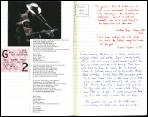Thursday, November 21, 2013
Emergence
Here's another work of art that recently arrested my attention on Tumblr. I've always been interested in art, and particularly drawing, that has a realistic center of interest that seems to emerge out of the act of drawing, in some sense displaying both the product and the process. This drawing, but Sir William Russell Flint (via cacao tree) does that.
The foreground is sketched, the mountains in the background are partially rendered, and the most carefully rendered and darkest areas are in the middle of the picture. I love the strip of light blue on the right, and in fact the whole horizontal stripe of colors running across the painting just below center holds the whole thing together for me in a way that feels grounded and solid, even though the top and the bottom essentially evaporate. I like the way the mound of earth leading into the center of the picture from the lower left starts as pencil line and takes on color and mass as it recedes toward the center. I like the feel of the piece, the way the picture seems to come alive on the paper. If the whole thing had been colored and the details filled in, it would have become pretty much just another landscape, and would have been of much less interest to me. As it is, it generates in me a feeling of peacefulness as I look at it, as it illustrates and speaks to the watchfulness of its making. A lot of art seems to want to erase or disguise all evidence of its gestation. I'm drawn to art that includes that evidence. Here's another such drawing, "The Door to Freedom," by the often disturbing but always interesting Egon Schiele (via iamjapanese):
The door is sketched. The lock is painted, and the eye is drawn through the bars above the door to the color of the outside world. Less is more.
Wednesday, November 20, 2013
In Praise of Matisse
I came to Matisse pretty late in the evolution of my art education. I had heard of him, of course, and had a couple of his iconic images (like "http://en.wikipedia.org/wiki/Dance_(Matisse)The Dance") parked in my brain. Once I started painting on my own, I came to appreciate his originality, his daring, his flexibility, his sense of color. Over the last few years, I've been even more impressed by his versatility and the sheer volume of his works. Since I've been keeping my Tumblr blog, I keep bumping into pictures by Matisse that I have never seen before, and they almost always knock my socks off. Like this one:
 |
| Reading Woman with a Violet Dress (1898) |
Look at it as an exercise in color and form, and it's a pretty delicious abstract: a wonderful mixture of shapes and tones and movements that echo one another and move our eye around in a largish circle. Purple is a tough color to work with, which is why a lot of artists avoid it. (How many purplish paintings can you call to mind?) And yet here the violet tones manage to feel warm and inviting. There are strategically place elements of gold in the foreground that help to accent the blues and reds elsewhere.
Look at it with the title in mind, and there she sits, hair in a bun, reading her book (or magazine, perhaps), table laden beside her, light coming in from above and to the right. Her dress is a study all in itself, no single color anywhere, but a scumbling of blues and reds and whites that "reads" like draped cloth but in no single place actually looks like it. In fact, there's not a patch of solid color anywhere in the picture. The intermixing and only partial blending of the colors gives the picture its painterly resonance. Everywhere you look there's something interesting going on in terms of the "how."Look at how economically the wine bottle, the cake, and the fruit are rendered. Look at the shadowed end of the white tablecloth in the foreground at the far left; surely no white tablecloth ever actually took on the turquoise hue Matisse has selected, but in this context that color—or mixture of colors—works perfectly. Look at the wall in the upper right background: not a square inch of solid color anywhere. One imagines Matisse wielding his brush with energy and rapidity and total self-assurance. You can see the brushwork everywhere, infer the movement and direction of the strokes. What you can't imagine—at least I can't—is how it must be to be able to paint like that. Looks easy enough, but go try it and see what happens. In any event, it's a gorgeous painting, and my guess would be that there are many people who know and love Matisse who have never seen it.
Subscribe to:
Comments (Atom)











